In the 2023/24 season, under manager Miron Muslić, Cercle Brugge enjoyed their best season in over a decade and a half.
Groen en Zwart managed to finish in fifth position, which was enough to see them earn a return to continental football for the first time in 14 years via the UEFA Europa League qualifiers.
Cercle enjoyed steady growth over the previous couple of seasons after nearly falling a level in 2020/21.
They finished 10th and eighth in the subsequent campaigns, respectively, before their highest league finish since 2008 last term.
We are almost at the halfway point in the current Belgian Pro League season, and 2024/25 has been a much different story so far for Cercle, who are sitting second from bottom in the league only ahead of newly promoted Beerschot.
This tactical analysis and team-focused scout report will examine the reasons behind Cercle’s poor start in Belgium this campaign and whether it’s just a rough patch or something deeper going wrong with the team’s tactics at the Jan Breydelstadion.
Cercle Brugge Changes From Last Season
For a more even comparison, this analysis will examine the final 12 league games of the 2023/24 season and the first 12 played so far this term.
In the final 12 games of last season, under Miron Muslić’s formation, Cercle set up in a 4-2-3-1 scheme, using 17 different players in their starting lineup.
So far this season, they have alternated between multiple setups and schemes, with 3-4-3, 3-5-2, and 4-4-2 diamond being some other formations they’ve deployed in addition to their standard 4-2-3-1 approach.
They’ve also used 23 different players at some point in the starting lineup, which is six more than last year’s sample used in this comparison.
They’ve also lost five of the 17 players they used in those games last term.
Three of those who left were defenders, with mainstays Hugo Siquet and Jesper Daland joining Club Brugge and Cardiff City, respectively.
The former had only been on loan at Cercle last year.
The other defender was Boris Popović, who went on loan to Portuguese club Arouca.
Attacking midfielder Félix Lemaréchal also returned to Monaco from a loan spell before eventually joining Strasbourg.
Central midfielder Leonardo Lopes’ deal wasn’t renewed, so he left on a free.
Cercle was also busy in the summer market acquiring players, with nine new players coming in and left-back Nazinho’s loan from Sporting CP being made permanent.
With a relatively big turnover of half the squad, frequent tactical changes, and a balancing act between the league and Europe that wasn’t there last year, perhaps these are all factors in the stark difference between Cercle’s performances in the Belgian Pro League between these two seasons.
But let’s examine some data to make further comparisons and see if there’s more evidence of what else has changed.
Cercle Brugge Data Analysis
Last year, Total Football Analysis analysed Miron Muslić’s coaching style at Cercle Brugge, highlighting their high pressing and direct approach under the Bosnian-born manager.
Let’s examine how or if those principles have been altered since the business end of last season.
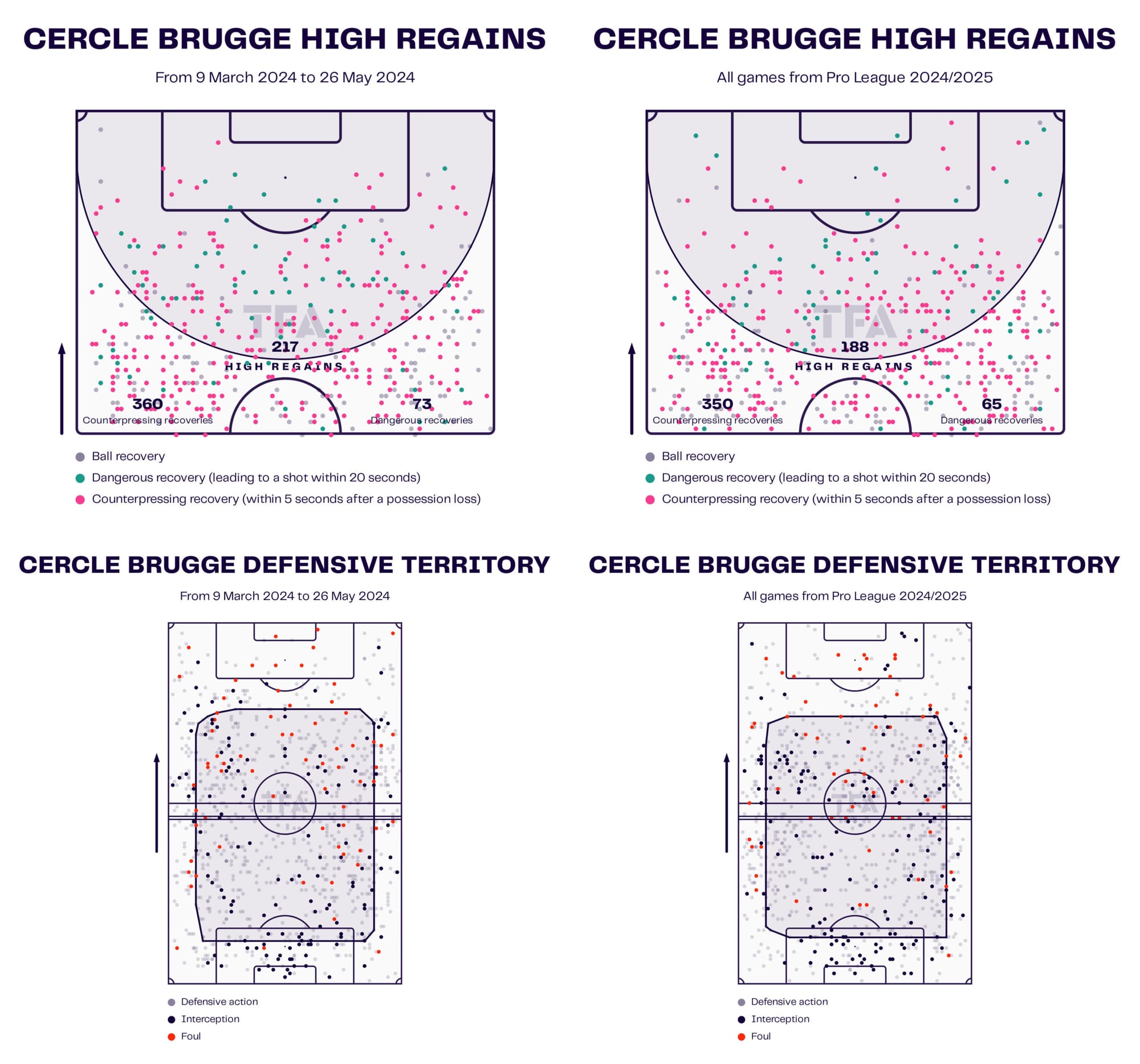
The data viz above displays Cercle’s high regains, and defensive actions from the last 12 league games of 2023/24 and the first 12 played so far in the current season.
The two sets of maps are pretty identical, and the numbers also support that, as they look similar across both documented periods, particularly in counter-pressing and dangerous recoveries.
Despite these similarities across both periods, Cercle have conceded an average of 1.73 goals a game in the league so far this term, more than half a goal more than the 1.08 at the tail end of last season and 1.2 for the entire 2023/24 league campaign.
This has left them with the joint third-worst defensive record in Belgium this season after they had the fifth-best record last season.
This suggests that the most significant change from last season’s success has been their defensive decline so far in 2024/25.
Before that viewpoint can be consolidated, further examination of the attempts they’ve allowed across both periods will be required to determine whether their defensive issues are more than meets the eye.
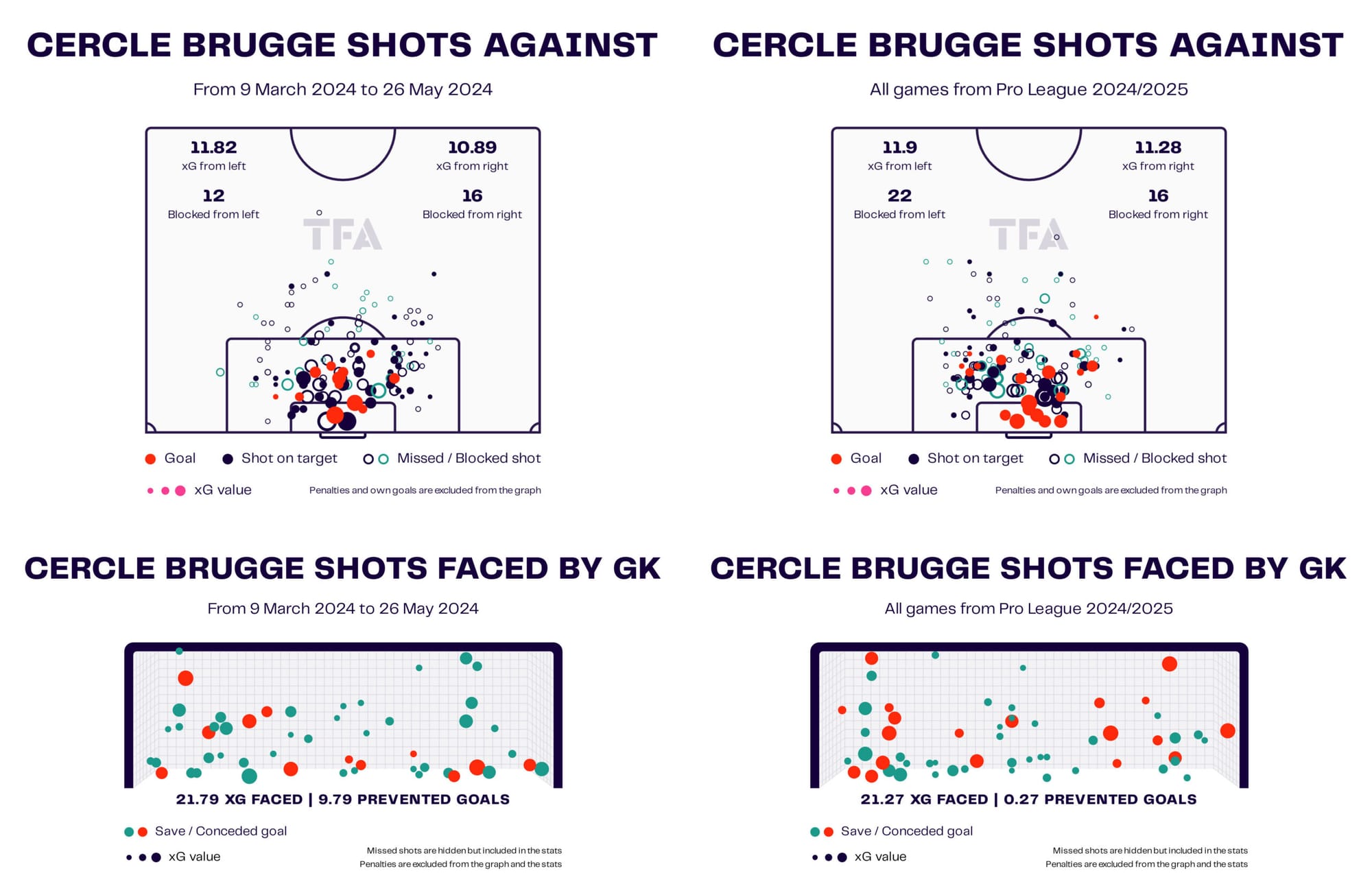
The data visualisation above displays the shots that Cercle have allowed across the aforementioned periods from this and last season, focusing on the opposition’s shot locations and the shots that Cercle has directly faced at their goal.
Let’s break both of them down.
In the first set of maps, which highlights their shots against and where they’ve come from, one thing that jumps out is the marginally higher xG and quantity of blocked shots they’ve had this season compared to the end of the last.
With 10 more blocks from both sides combined, it’s fair to say that Cercle has been busier defensively this season, and the numbers above clearly support that.
But what’s interesting to note is that Cercle has actually conceded fewer shots against overall in this season’s games than in the last 12 from last season, with an average of 10 shots against compared to the latter period’s 12.
And what’s even more striking is the second set of maps, which display the shots faced directly at their goal.
Although the xG faced is similar, the massive difference in prevented goals is very telling, with nine fewer prevented goals this season in comparison to the right.
So, while both maps tell us that Cercle are generally defending similarly to last year, the deeper analytics that highlight the shots they’ve faced show that they’ve conceded higher-quality chances of a higher xG value this term, with far more danger posed in and around their six-yard box from the first set of maps.
Offensively, their xG average and number of chances generated per game have also dropped from last season.
On average, they generate 1.49 xG from 11 shots a game, compared to 1.79 xG from 13 attempts last year.
After scoring 44 or more goals in each of their last three campaigns, at their current strike rate, Cercle are unlikely even to hit 40 this year unless they start putting away their chances more frequently and efficiently.
While their offensive production has declined somewhat, their attack is still statistically ranked in the top ten of the league so far.
It’s fair to say that their defensive flaws, which we’ve covered in this data analysis, are the bigger reason for their current league standing and the bigger drop-off of the two from last year.
Cercle Brugge Issues In Transitional Defending
So, we’ve uncovered some of the deeper defensive issues plaguing Miron Muslić’s tactics in the Belgian Pro League so far this campaign.
Now let’s look at some of those examples at play where their attempts to push up and press have faltered and left them exposed at the back, leading to big goalscoring opportunities and, inevitably, goals allowed to the opposition.
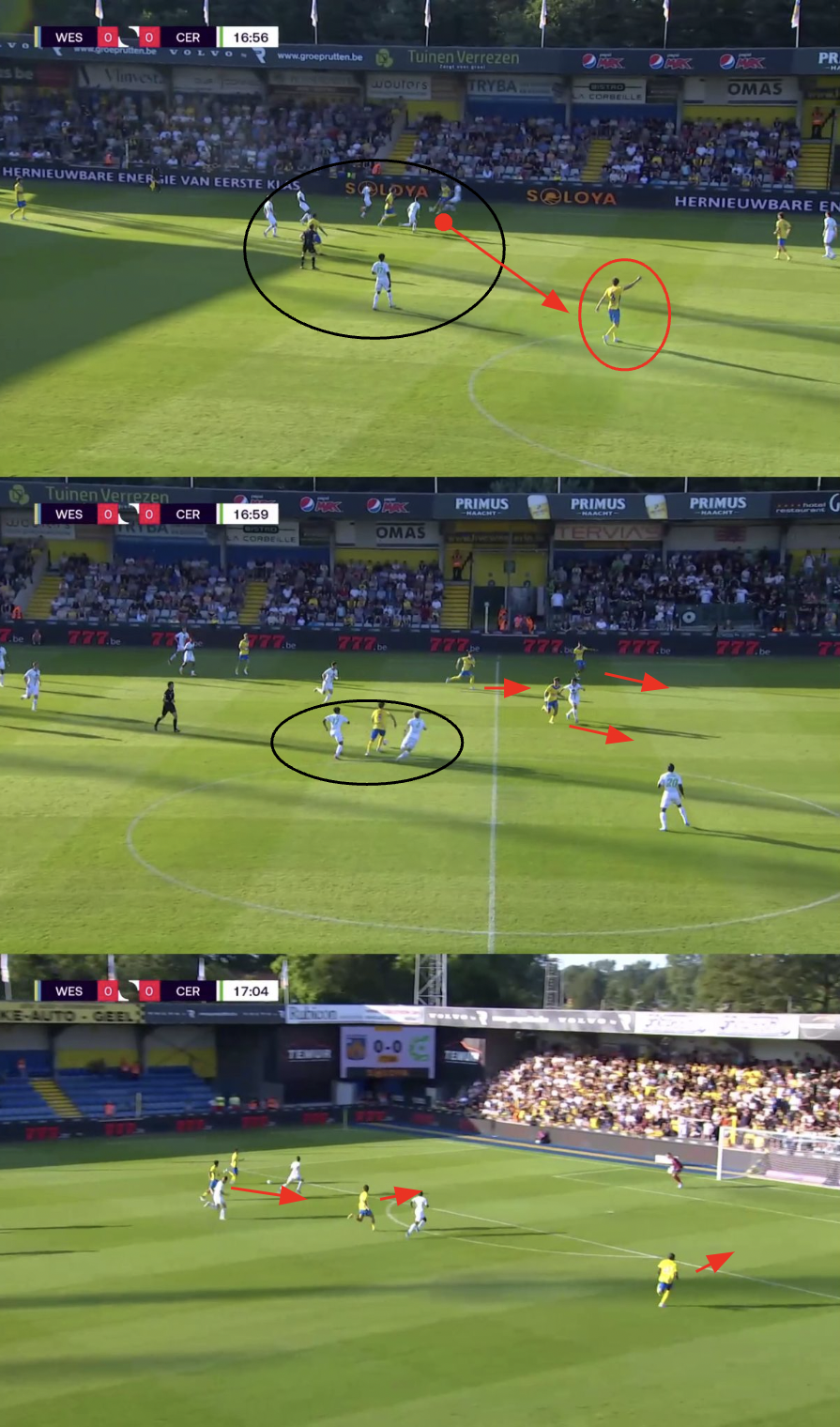
The first one above is from the opening game against Westerlo.
We can see six Cercle players in the circled area, all trying to push up on the near-ball side as part of their pressing strategy under Miron Muslić’s style of play to win back possession high up the field.At the same time, there’s a wide-open Westerlo player in the middle with his arm raised, looking for the ball to come to him, aware of all the space Cercle had left behind as a result of their pressing high up the field.
The ball quickly comes to him, which, as we can see in the last graphic, leads to a 4v3 opportunity to score in transition and eventually leads to Westerlo taking the lead.
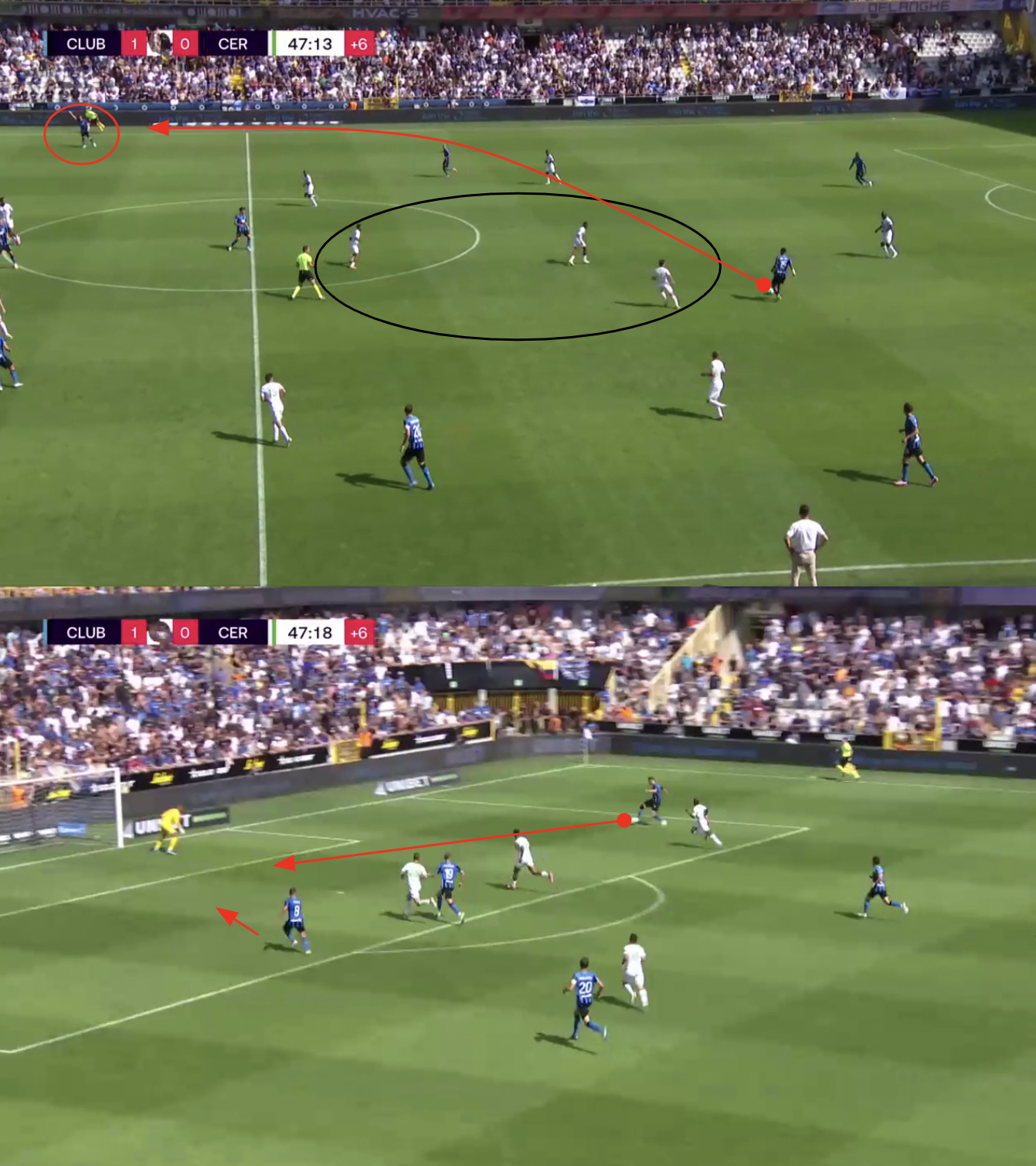
In this following example against Club Brugge, we can see a similar scenario: Cercle players pushing up from deep to try to win the ball, and the opposition exploiting the gaps left behind.
In the first image, we can see both full-backs, Gary Magnée and Nazinho, tucked inside.
This leaves a Club Brugge winger wide open on the far side for the switch pass, which is spotted and picked out for him.
As the play advances into the Cercle penalty area, we can see the opposite winger making a run to the far post, expecting the ball to arrive there via a low cross.
This is precisely what happened, as Miron Muslić’s Club Brugge doubled their lead just before half-time.
So far, these examples give a sense of the risks associated with Cercle’s tendency to defend off the ball, with players pushing up even from defensive positions instead of dropping back to defend zonally.
The opposition also seems to have figured out how to circumvent its press and create high-quality scoring chances.
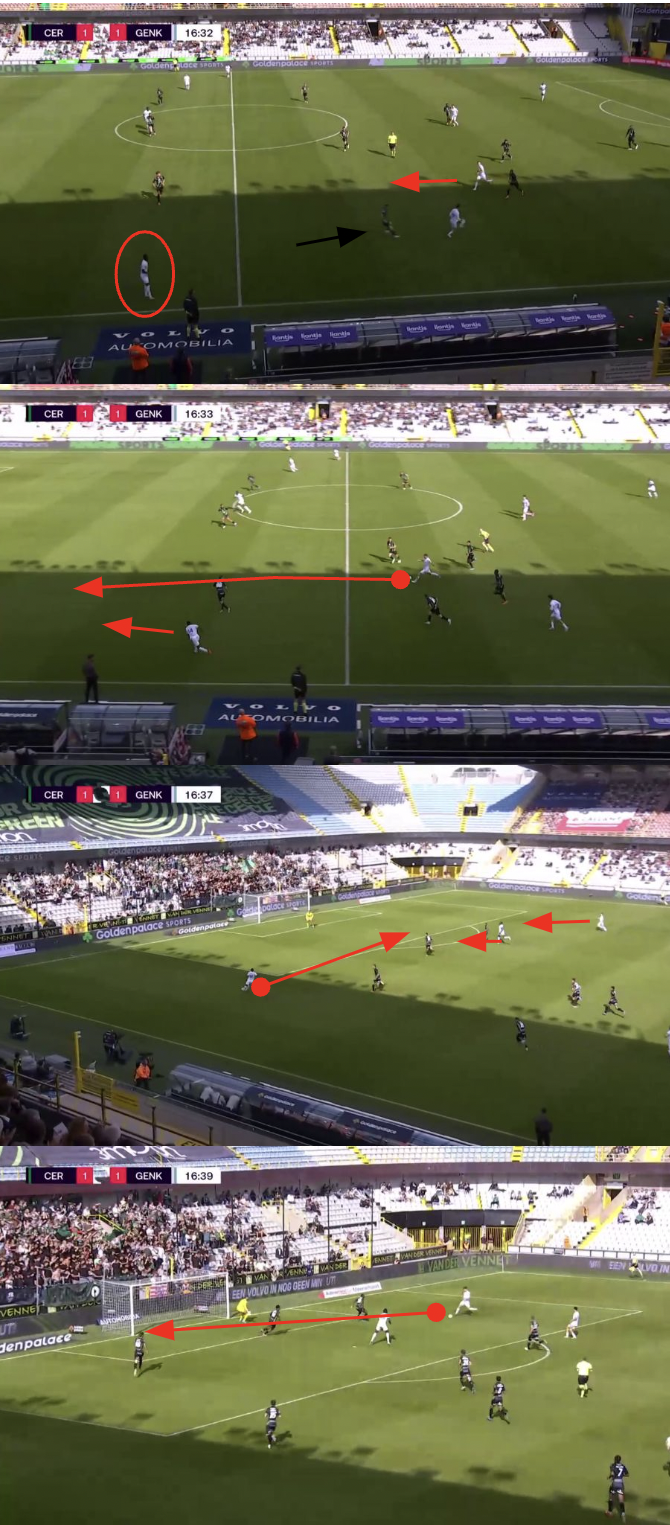
The above set of graphics is from the game against Genk.
Again, we can see a player stepping out of defence to push up on the near-ball side, with Magnée being that player in the first image.
This inevitably leaves space on his side for the Genk left winger to attack and make the run in behind the covering centre-back, anticipating a through ball in behind which does arrive.
Then we can see another 3v3 opportunity to score for the opposition, with an early ball arriving at the far post, where Genk is able to finish off the chance clinically to take a big early lead.
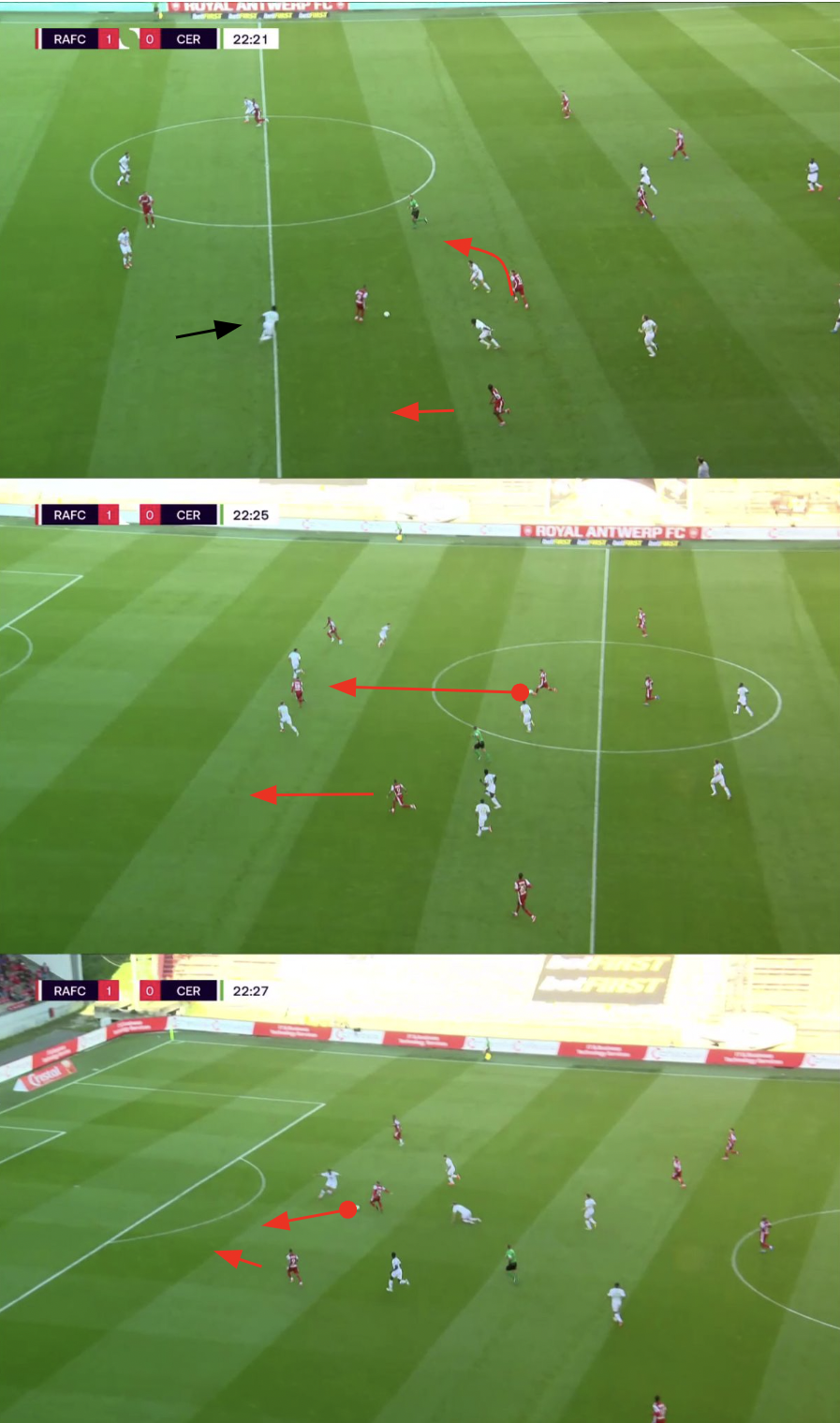
This last example is from the game against Antwerp, where, once again, a Cercle defender steps up to try to nick the ball off the opposing player.
With three Cercle players all moving towards the same player, we can see an Antwerp midfielder cleverly curve his run behind them on the blind side and into a position where he can offer himself as a passing option to his teammate under pressure.
His effort is spotted, leading Antwerp to attack with three runners off the ball further ahead.
There are just three defenders on Cercle’s end to provide coverage.
In the last image, we can see the receiving striker in a 1v1 situation with the central centre-back.
With a teammate on his near side to pick out with space ahead of him, the Cercle defender gambles and tries to nick the ball instead of trying to hold up the striker.
He misses out, and Antwerp is gifted a chance to score 1v1 against the goalkeeper, which they duly dispatch to take a big early lead. Once again, this was on Cercle’s negative side.
In all of these examples, there are clear patterns in Cercle’s defence that lead to very dangerous chances given up to the opposition.
Most of them involve taking too many risks with their pressing and very little defensive coverage to compensate.
This has led to the opposition giving up high-quality opportunities, which is why their XG against and prevented goals have been much worse so far this season.
Perhaps there is an element of Muslić’s pressing strategy being figured out by the rest in Belgium and knowing what to anticipate from them and how to hurt them in the spaces they leave behind.
But it’s something that can be worked on with some tweaks, although it’s something they haven’t been able to work out just yet this season.
Conclusion
As we’ve seen in this analysis, Cercle Brugge are generally playing the same way this year as they did last year in their fifth-place finish, but the defensive issues that have led to higher-quality chances being given up to the opposition have hurt them dearly.
The good news is that these issues can be fixed.
It’s a matter of key moments during games where they’ve let themselves down defensively rather than becoming a bad team overnight.
Balancing multiple competitions and squad rotation is tough at this level, and they are still trying to figure it out.
Still, if they can iron out the chinks in their armour in terms of their counter-pressing and defending, they should start to see more improvement across the board and a rise back up the standings.

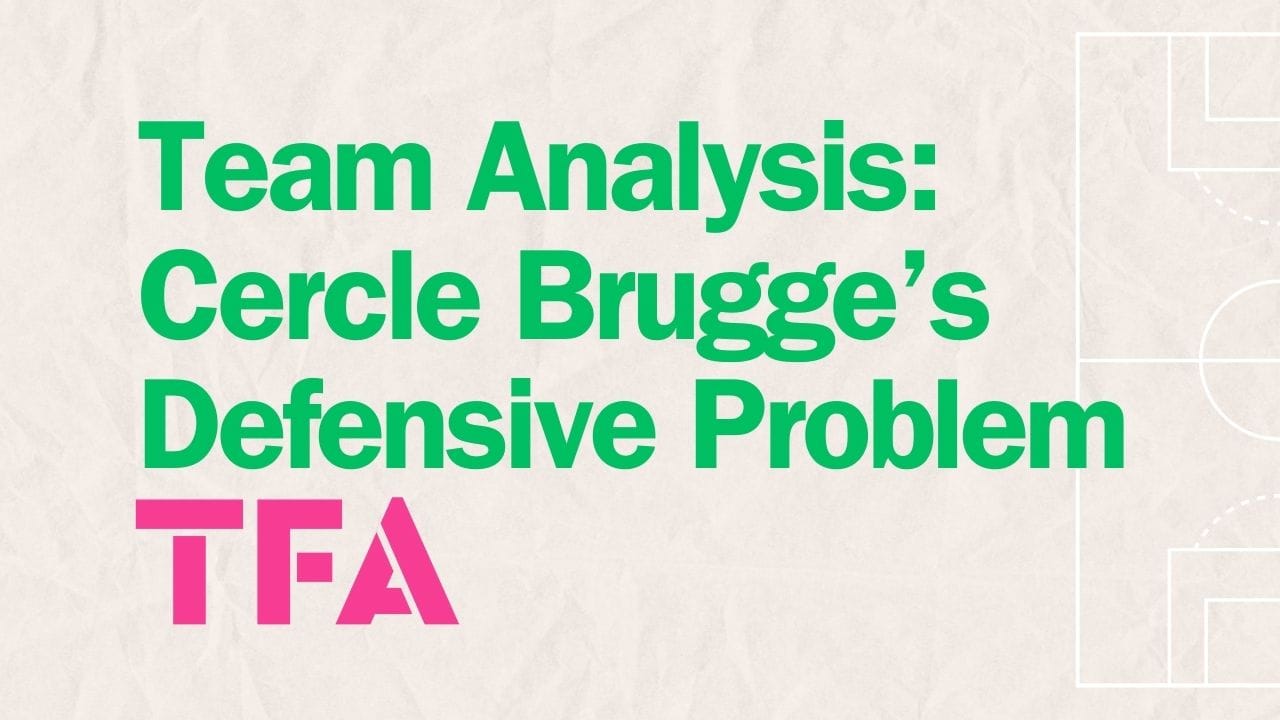




Comments